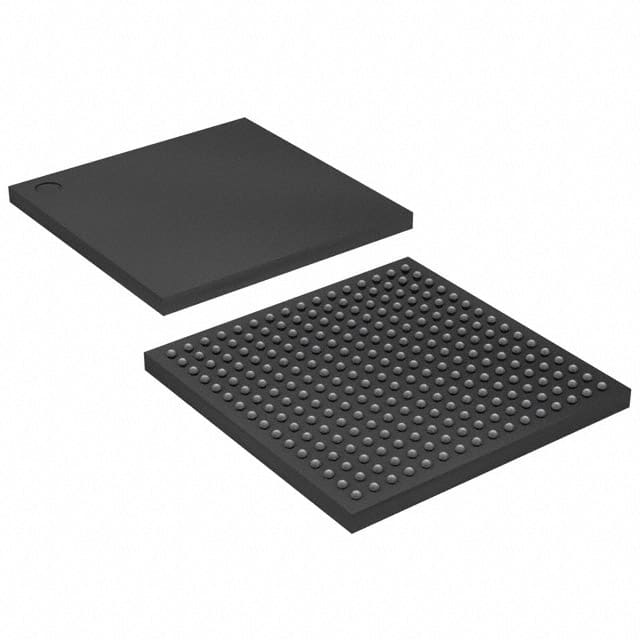EP4CE15F17C8L
Product Overview
- Category: Programmable Logic Device (PLD)
- Use: EP4CE15F17C8L is a PLD used for digital logic design and implementation.
- Characteristics:
- High-performance device with low power consumption
- Offers high-speed data processing capabilities
- Provides flexibility in designing complex digital circuits
- Package: The EP4CE15F17C8L comes in a compact LQFP package.
- Essence: EP4CE15F17C8L is an essential component for building advanced digital systems.
- Packaging/Quantity: Typically sold in reels or trays, containing multiple units per package.
Specifications
- Logic Elements: 15,408
- Embedded Memory: 414 Kbits
- Maximum User I/O Pins: 179
- Clock Networks: 8
- PLLs: 2
- Operating Voltage: 1.2V
- Speed Grade: 8
Pin Configuration
The EP4CE15F17C8L has a total of 179 pins, each serving a specific purpose in the device's functionality. The detailed pin configuration can be found in the manufacturer's datasheet.
Functional Features
- High-speed data processing: EP4CE15F17C8L offers fast data processing capabilities, making it suitable for applications requiring real-time performance.
- Flexibility in design: With its programmable nature, this PLD allows designers to create custom digital circuits tailored to their specific requirements.
- Low power consumption: EP4CE15F17C8L is designed to minimize power consumption, making it energy-efficient and suitable for battery-powered devices.
- Embedded memory: The device includes a significant amount of embedded memory, enabling storage and retrieval of data within the PLD itself.
Advantages and Disadvantages
Advantages: - High-performance capabilities - Flexibility in design - Low power consumption
Disadvantages: - Limited number of I/O pins compared to higher-end models - Steeper learning curve for beginners due to its complexity
Working Principles
EP4CE15F17C8L is based on the field-programmable gate array (FPGA) technology. It consists of a matrix of programmable logic elements interconnected by configurable routing resources. The device can be programmed using hardware description languages (HDLs) or graphical tools, allowing designers to define the desired functionality and interconnections.
Detailed Application Field Plans
EP4CE15F17C8L finds applications in various fields, including:
- Communications: Used in networking equipment, routers, and switches for high-speed data processing.
- Industrial Automation: Employed in control systems, robotics, and process automation for real-time control and monitoring.
- Consumer Electronics: Integrated into smart devices, gaming consoles, and multimedia systems for enhanced performance and flexibility.
- Automotive: Utilized in automotive electronics for functions like engine control, infotainment systems, and driver assistance systems.
- Medical Devices: Incorporated into medical imaging equipment, patient monitoring systems, and diagnostic devices for efficient data processing.
Alternative Models
- EP4CE22F17C8L: A higher-end model with increased logic elements and I/O pins.
- EP4CE10F17C8L: A lower-cost option with reduced logic elements and I/O pins.
- EP4CE30F29C8L: A more advanced model with additional embedded memory and PLLs.
Note: Please refer to the manufacturer's documentation for complete details on alternative models.
This entry provides an overview of the EP4CE15F17C8L PLD, including its basic information, specifications, pin configuration, functional features, advantages and disadvantages, working principles, application field plans, and alternative models.
기술 솔루션에 EP4CE15F17C8L 적용과 관련된 10가지 일반적인 질문과 답변을 나열하세요.
Sure! Here are 10 common questions and answers related to the application of EP4CE15F17C8L in technical solutions:
Q: What is EP4CE15F17C8L? A: EP4CE15F17C8L is a field-programmable gate array (FPGA) chip manufactured by Intel (formerly Altera). It offers programmable logic, memory, and digital signal processing capabilities.
Q: What are some typical applications of EP4CE15F17C8L? A: EP4CE15F17C8L can be used in various technical solutions such as industrial automation, robotics, telecommunications, medical devices, automotive systems, and more.
Q: How does EP4CE15F17C8L differ from other FPGA chips? A: EP4CE15F17C8L has specific features like 15,408 logic elements, 504 kilobits of embedded memory, and 66 general-purpose I/O pins that differentiate it from other FPGA chips.
Q: Can EP4CE15F17C8L be programmed using popular hardware description languages (HDLs)? A: Yes, EP4CE15F17C8L can be programmed using HDLs like VHDL or Verilog, which are widely used in the FPGA design industry.
Q: Is EP4CE15F17C8L suitable for high-speed data processing applications? A: Yes, EP4CE15F17C8L supports high-speed serial transceivers, making it suitable for applications requiring fast data processing and communication.
Q: Can EP4CE15F17C8L interface with external devices? A: Yes, EP4CE15F17C8L provides various interfaces such as SPI, I2C, UART, and GPIOs, allowing it to communicate with external devices.
Q: Does EP4CE15F17C8L support real-time processing? A: Yes, EP4CE15F17C8L can be programmed to perform real-time processing tasks, making it suitable for applications that require quick response times.
Q: Can EP4CE15F17C8L be used in safety-critical systems? A: Yes, EP4CE15F17C8L offers features like error detection and correction, redundancy, and fault tolerance, making it suitable for safety-critical applications.
Q: Is EP4CE15F17C8L power-efficient? A: EP4CE15F17C8L has power-saving features like clock gating and dynamic power management, which help optimize power consumption in the system.
Q: Are there any development tools available for programming EP4CE15F17C8L? A: Yes, Intel provides Quartus Prime software, which is a comprehensive development environment for designing, simulating, and programming EP4CE15F17C8L-based solutions.
Please note that the specific details and answers may vary depending on the context and requirements of the technical solution.


